Investing in silver bullion is a popular choice for both novice and seasoned investors. Silver, often referred to as “poor man’s gold,” offers a more affordable entry into precious metals investing. With its historical value as a form of currency and a hedge against inflation, silver bullion can be an essential addition to a diversified investment portfolio. This guide provides a detailed look at how to buy silver bullion, ensuring that you make informed and strategic decisions.
Understanding Silver Bullion
Silver bullion refers to physical silver in the form of bars, coins, or rounds. Unlike numismatic coins, which carry value due to their rarity and historical significance, bullion’s value is primarily based on its silver content and current market price.
Types of Silver Bullion:
Silver Bars: Available in various weights, from one ounce to 1,000 ounces. Larger bars typically have lower premiums over the spot price of silver.
Silver Coins: Minted by government mints, these coins, such as the American Silver Eagle or Canadian Silver Maple Leaf, often carry a slightly higher premium due to their recognition and guaranteed purity.
Silver Rounds: Similar to coins but produced by private mints. They usually have lower premiums but lack the government-backed guarantee.
Steps to Buy Silver Bullion
1. Determine Your Investment Goals
Before purchasing silver bullion, clarify your investment objectives. Are you looking for a long-term hedge against inflation, a tangible asset for economic uncertainties, or simply diversifying your investment portfolio? Your goals will influence the type and quantity of silver bullion you should buy.
2. Research the Market
Understanding the current market conditions is crucial. Monitor the spot price of silver, which fluctuates based on supply and demand, economic indicators, and geopolitical events. Websites like Kitco, MarketWatch, and the London Bullion Market Association provide up-to-date silver prices.
3. Decide on the Type of Silver Bullion
Based on your investment goals and budget, decide whether to invest in silver bars, coins, or rounds. Each has its advantages:
- Silver Bars: Best for bulk purchases due to lower premiums.
- Silver Coins: Ideal for those seeking easily recognizable and tradable forms of silver.
- Silver Rounds: Good for investors looking for low premiums without the need for government-backed guarantees.
4. Choose a Reputable Dealer
Selecting a trustworthy dealer is essential to avoid scams and ensure you receive genuine products. Consider dealers who are members of professional associations like the American Numismatic Association (ANA) or the Professional Numismatists Guild (PNG). Check reviews, ratings, and years of operation. Some well-known dealers include:
- APMEX (American Precious Metals Exchange): Offers a wide variety of silver bullion with competitive prices.
- JM Bullion: Known for excellent customer service and a broad selection.
- Kitco: Provides a comprehensive suite of precious metal products and market information.
5. Understand the Costs Involved
When buying silver bullion, be aware of the various costs:
- Spot Price: The current market price of silver per ounce.
- Premiums: The markup over the spot price, which covers manufacturing, distribution, and dealer profit. Premiums vary based on the type of bullion and market demand.
- Shipping and Handling: Fees for delivering your silver bullion safely.
- Storage Fees: If you choose to store your silver in a secure facility rather than at home.
6. Make the Purchase
Once you have selected your dealer and bullion type, proceed with the purchase. Ensure the transaction is secure, and retain all receipts and documentation for future reference. Payment methods vary by dealer but typically include bank transfers, credit cards, PayPal, and cryptocurrencies.
Storage Options for Silver Bullion
Proper storage of your silver bullion is critical to protect your investment from theft, damage, and environmental factors.
Home Storage:
- Safes: Invest in a high-quality safe that is fireproof and bolted to the floor.
- Hidden Locations: Conceal your silver in unexpected places within your home.
Professional Storage:
- Bank Safe Deposit Boxes: Secure but may have accessibility limitations.
- Third-Party Depositories: Facilities that specialize in precious metal storage, offering high security and insurance.
Selling Silver Bullion
Knowing how to sell silver bullion is just as important as buying it. Here are the steps to follow:
Monitor Market Conditions: Sell when the market conditions are favorable, ideally when the silver price is high.
Choose a Selling Method: Options include selling directly to dealers, through online platforms, or at precious metal shows.
Verify the Buyer: Ensure the buyer is reputable to avoid fraud and receive fair market value.
Understand Tax Implications: Be aware of capital gains taxes that may apply to your profits.
Risks and Considerations
Investing in silver bullion comes with certain risks and considerations:
Market Volatility: Silver prices can be highly volatile, influenced by economic conditions, industrial demand, and investor sentiment.
Storage Risks: Physical silver can be stolen, lost, or damaged if not stored properly.
Liquidity: While silver is generally easy to sell, finding a buyer willing to pay your asking price can sometimes be challenging.
Premiums and Fees: High premiums and fees can reduce your overall returns, especially for small quantities.
See Also Is Junk Silver a Good Investment?
Conclusion
Buying silver bullion can be a rewarding investment, providing a hedge against inflation, economic uncertainties, and market volatility. By understanding the types of bullion available, researching the market, choosing a reputable dealer, and storing your silver securely, you can make informed decisions that align with your financial goals. Whether you’re a novice investor or an experienced one, silver bullion offers an accessible and tangible way to diversify your investment portfolio.


